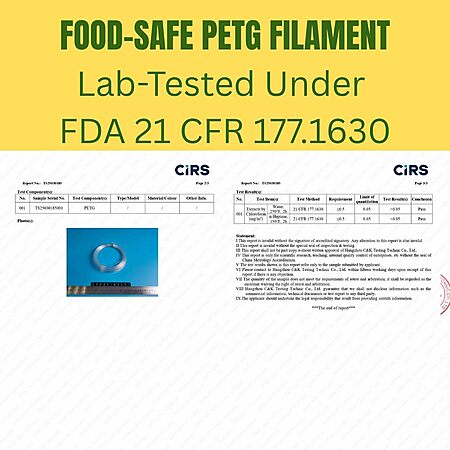About this item
Food Contact Safe PETG Filament: Our high-quality PETG filament has been lab-tested and fully complies with FDA 21 CFR 177.1630 regulations for Food Contact Safety. No harmful substances detected, ensuring your 3D prints are safe for use in food-related applications.
Widely compatible with the majority of FDM 3D printers, including high-speed 3d printers such as Bambu lab x1c, p1s, p1p, a1 etc, ensuring greater convenience and efficiency in your printing process.
Hassle-free printing experience with no warping, no jamming, and great layer adhesion, while also offering consistent color and precise dimensional accuracy. For optimal results, it's recommended to turn off the fan during the initial layer to enhance bed adhesion.
Turn off the fan for the first layer for improved bed adhesion. Nozzle Temperature: 220-240°C. Print Bed Temperature: 60-80°C. Ensure the filament end is securely fastened to prevent unwinding after the initial print.
Offers exceptional clarity and a glossy finish, along with waterproof properties. It's highly durable, with excellent impact and mechanical strength, as well as impressive thermal and chemical resistance.
https://www.amazon.com/dp/B0DG5P8SSR
Leave a Comment
3 Comments
Sign up for a Slickdeals account to remove this ad.
Dry food storage? Food machine part replacement? Serving utensils?
Sanding? Sanitizing? Sealing?
Raw Material:
PETG, in its pure form, is often used for food and beverage packaging, including bottles and containers, and is regulated by the U.S. Food and Drug Administration (.gov).
3D Printing Considerations:
While the material itself may be food-safe, the 3D printing process introduces potential issues.
Layer Lines: 3D printing creates layers, which can form small gaps and crevices that are difficult to clean and can harbor bacteria.
Nozzle Material: Brass nozzles, commonly used in FDM 3D printers, may contain lead or other materials that could leach into the print, affecting food safety.
Additives and Colorants: Filament manufacturers may add colorants or other additives to the PETG, some of which may not be food-safe.
Food-Safe PETG Filaments:
Some manufacturers produce PETG filaments specifically for food contact applications, ensuring that the material, including any additives, is certified as food-safe.
Recommendations:
Use Certified Food-Safe Filament: Opt for filaments explicitly labeled as food-safe and sourced from reputable manufacturers.
Consider Coating: If using PETG for food contact, consider coating the printed part with a food-safe sealant or epoxy to fill in layer lines and improve cleanability.
Hygiene Practices: Follow strict hygiene practices during and after printing, including washing the printed object with soap and water before and after each use.
Avoid Direct Contact for Certain Uses: For items like cookie cutters or other tools intended for direct food contact, ensure they are coated with a food-safe sealant or use a mold instead of printing directly.
Dishwasher Safety:
PETG is generally dishwasher safe, but it's essential to consider the temperature of the dishwasher and potential exposure to harmful chemicals.
Purple and grey both available at this price. Black for $3 more.
Not sure that it is or isn't "slick" for a specialty filament, but I guess I'll pick up a spool in case I ever need it. I mean, my wife has definitely _never_ said I have too much filament. Thanks, OP... Just not from my wife.
Leave a Comment